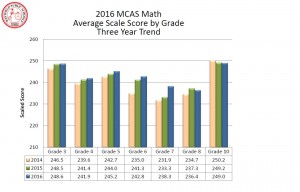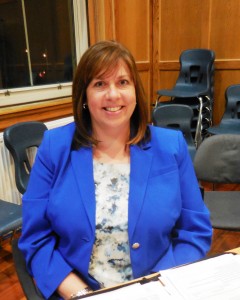WESTFIELD – At the state of the district presentation to the School Committee Monday evening, Susan Dargie, director of curriculum and instruction for Westfield Public Schools, said the district has been focusing for the past five years on new curriculum for English language arts and math, and will now be shifting its focus to other areas, including STEM (science, technology, engineering and math), health and social studies.
Speaking about the “new math” curriculum last week, Dargie said it was introduced five years ago in the elementary schools, and three years ago in the middle school. The curriculum was a departure from the traditional way of teaching math and at first caused some confusion among parents.
“We get it (questions) from elementary school parents that are trying to help their children with their homework. They want to be able to understand it,” Dargie said. She encourages parents to connect with the teachers, and use resources available on the district websites. The district has also offered family nights, to discuss the changes with parents.
The new curriculum, which is enVisionMATH for the elementary school and Big Ideas for the middle school is more conceptualized, according to Tara Brandt, supervisor of STEM (science, technology, engineering and math) for K-12 in Westfield.
“The biggest difference is the way the standards have been organized. There is tight cohesion. It’s like a ladder with steps that build,” Brandt said. As skills are taught, students memorize methods with each step. “Now, we understand why the rules came about – why, not just how,” Brandt added.
Dargie gave the example of the old way students, including herself, were taught to divide fractions, as in ½ divided by ¼.
“Flip the second fraction, multiply. Ours is not to reason why, just invert and multiply. This is what you do when you see a fraction divided by a fraction. They don’t understand why,” Dargie said.
Brandt explained that now students are taught more with the concepts. “What’s greater – 7/8 or 6/7? Visualize a pre-cut pie into smaller pieces,” she explained.
Dargie said with the old method, when students would get into more advanced math concepts, it was a house of cards that would fall down. Now it’s about letting kids explore mathematically.
Dargie said the new math was new also for staff. She said when they started, 50% of the staff in Westfield had more than 20 years of teaching. She said the district provided a good deal of professional development, and Brandt was instrumental in providing professional development through the 5- colleges. She said it is an ongoing effort, once the district recognized was needed.
“This was the first new math program in well over ten years. We have job embedded professional development,” Dargie said.
Another help for teachers has been math coaches. There are four math coaches split between the six elementary schools, and one math coach for the middle schools. Westfield High School has a math department head, and there is a lead teacher at Westfield Technical Academy.
Math coaches help to interpret assessment (testing) in the classroom, and give teachers ideas for differentiation among student groups, and teaching for understanding.

3-year average MCAS Math scores from State of the District presentation, available at www.schoolsofwestfield.org.
As Dargie explained, “If I taught a standard for mastery and, at assessment, 67% of the students didn’t know that standard, we need to reteach it.” She said the teacher might work with a colleague whose class achieved 97% mastery.
She said if 15% of the students struggled with mastery, then they’d pull out those students for more work on the standard. She said they are using data to make sure they are differentiating.
Dargie said students still learn math facts, and teachers are encouraged to save the more traditional work. A district math committee is also working on a math plan, similar to the literary plan that has evolved. Communicating to stakeholders, such as the parents, the community, the City Council, is also important.
“We need to ensure our students are learning what they need to learn to be successful,” Dargie said.
Dargie and Brandt are both enthusiastically behind the “new math.”
“I think it’s the only way to learn math. I wasn’t taught to understand. I went along with whatever the teachers said. We’re taking away the mystery. If you can play with numbers, you own them,” Brandt said.
People still self-identify into categories such as being a number person or a word person, Dargie said. She said this way of helping students learn is going to grow the math number. “There’s more of an openness. Kids aren’t compartmentalized,” she said.
“There is no such thing as a math gene. Students are competing on a higher and higher level,” Brandt said. She’s also seeing more kids studying math in different grade levels.
They said they are seeing an increase in advanced scores, and a decrease in warnings. Brandt said the new standards teach for understanding why something is true.
“By increasing the ability of teachers to teach, we’ll see kids enhancing their performance. Continuous improvement – kids continue to improve,” Brandt said.
Dargie said they have also sold the teachers.
“Going back 16 & 20 years, research has shown how students learn to read. This framework has given us that for math – a window into how we learn early numeracy,” Dargie said. She said they know it works by working with the students, and seeing them solve a problem in the second grade using a strategy.
She said she has had feedback from teachers in Franklin Ave. and Abner Gibbs elementary schools.
“They were blown away. 25 year veterans said, I finally understand how my kids are learning math,” Dargie said.
Brandt said the state’s revision committee has put forward a recommendation for some changes in curriculum that will be voted on soon. But she said there won’t be glaring changes, just clarification, with understandable and acceptable changes.


